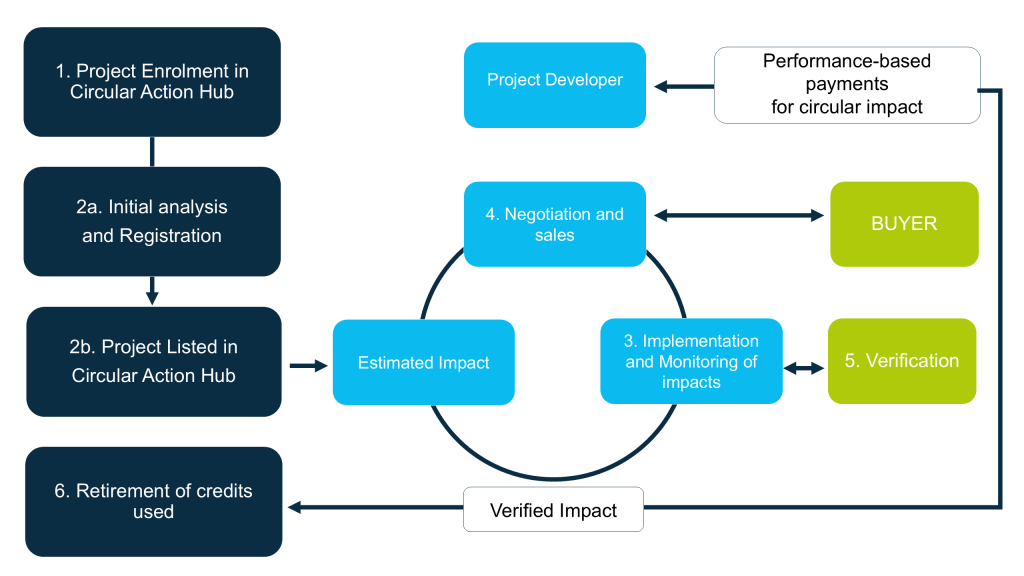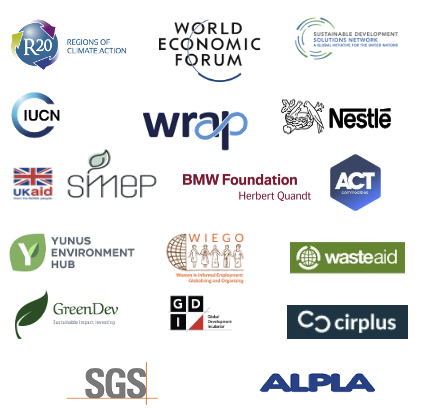The Circular Credits Mechanism™ (CCM) from BVRio is a system of performance-based payments for environmental services of circularity, striving for inclusiveness and wide social participation. It is a market tool for buyers and sellers of the environmental services related to the collection (recovery), sorting and appropriate destination of recyclable waste materials that today pollute our environment.
Through the use of credits, interested parties (the buyers – e.g., companies) can compensate for their waste footprint, by effectively subcontracting the services provided by sellers (e.g., projects, waste pickers associations, etc.) providing the environmental service of waste recovery and appropriate destination.
In the absence of polluter-pay regulations in some countries (e.g. Extended Producer Responsibility – “EPR” schemes), the tool can positively contribute to social and environmental impacts (e.g., low income groups in developing countries). For countries with existing EPR schemes, the Credits may be recognised as one of the ways of complying with these regulations.
To issue Circular Credits, projects must conform to the Circular Credits Mechanism Standard, and its Principles and Criteria. 
AN INCLUSIVE APPROACH TO THE PROJECT CYCLE
Traditional project cycles for environmental markets (e.g., carbon markets) require the validation, registration, independent verification, and issuance of credits before developers can receive any financial return. Transaction costs involved can be significant, and beyond the means of project developers.
The CCM was designed by BVRio, based on its experience with the Reverse Logistics Credit System in Brazil. The objective of the CCM is to be inclusive and accessible to all, especially SMEs and community-based operations.
For this reason, the CCM adopts an inverted project cycle where developers can post their offers based on self-declarations that are verified only after projects secure financial support. There are no costs associated with project registration and credit issuance, and all other transaction costs are covered by the buyers of environmental services.
Circular Credits are transacted exclusively through the Circular Action Hub’s marketplace, which also acts as its Registry.
The Project Cycle
Projects must follow the process described below to create and sell credits under the Circular Credits Mechanism:

Project registration form (PRF) completion describing the project activities, the situation prior to the project, the expected project benefits, and the monitoring plan. Click here to start the process.
Analysis and registration of the PRF, done by BVRio’s technical team, to ensure data completeness. The project proponent makes a self-declaration about the project’s expected environmental impact and its compliance with the CCS’s Principles and Criteria. After this:
The project is registered
An Estimated Amount of Circular Credits is allocated to the Project
Implementation of project activities and monitoring of results, updating the Estimating Amount reported to the Hub.
Negotiation and transaction of credits – Once a potential buyer or investor expresses interest in the project, the Hub will help parties negotiate and conclude a transaction, which could result in financial support to the project.
Verification of the results of the project – at this stage, the buyer will need to contract for verification of the project’s impact and its compliance with the Circular Action Standard’s Principles and Criteria. Once verification is concluded, the Verified Amount of Circular Credits is allocated to the Project and transferred to the Buyer.
Retirement of circular credits – once credits are used for any specific claim, the party must inform the Circular Action Hub in order to have these credits retired from the Project’s Registry.
Principles and criteria
Additionality
No Double Counting
Demonstrability
No Free-Riding
Fair Remuneration
Do no harm
Learning by Doing
PRINCIPLE 1. Additionality
The environmental impact of activities and projects must contribute to an improvement of historic trends of waste pollution. Positive lists are adopted for specific project types deemed additional by definition. See Guidance Note on Additionality for more info.
PRINCIPLE 2. No Double Counting
An essential requirement of the Circular Credits Mechanism is that the environmental impact related to the recovery and destination of waste should not be attributed to more than one entity. In practice, this means that credits cannot be issued for activities where this service has already been contracted and paid for (e.g., municipal waste collection services). Similarly, the credits can only be used once, to compensate for the footprint of a certain entity.
PRINCIPLE 3. Demonstrability – monitoring and verification
The amount of credits to be issued must be substantiated by evidence that demonstrates that the activity was conducted and that a certain amount of waste materials was indeed recovered and sent to an appropriate destination. This can be done using different types of documents, such as invoices/receipts associated with the sale of materials to recycling plants, bills of laden, transportation authorization, or balance records. This documentation must be kept and made available for third party verification, to substantiate the issuance of credits.
PRINCIPLE 4. No free-riding
Related to Principle 2, the CCM only recognises the environmental service if the activities are fairly paid for, in addition to any payment for the acquisition of physical recyclable materials. For instance, in the case where waste pickers are only paid for the sale of physical recyclable materials delivered by them to a buyer, the entity buying these materials are not entitled to claim the environmental service provided. It is understood that this is a transaction involving solely the purchase of waste materials as a feedstock for recycling plants, and not a contract for the provision of an environmental service. Payment for the environmental service must be over and above the payment for the recyclable materials purchased, creates a second revenue stream for its providers.
PRINCIPLE 5. Fair remuneration
Linked to the ‘no free riding’ criterium, the provision of this environmental service must receive fair remuneration, commensurate with the workload and the time required to the provision of the service. The Circular Credits Mechanism does not intend to establish minimum prices (prices will be determined through supply and demand market basis) but will provide an oversight to ensure that participants in the scheme do not adopt exploitative market practices.
PRINCIPLE 6. Do no harm
All projects are required to meet minimum social and environmental safeguards to ensure that the activities involved in the creation of credits do not cause harm to the parties involved.
PRINCIPLE 7. Learning by doing
Recognising that there is a huge diversity in terms of technologies available and approaches that can be used by projects in different parts of the world, with different circumstances, the CCM does not assume that a ‘one size fits all’ monitoring approach can be defined at the outset. Instead, the CCM adopts a ‘learning-by-doing’ approach to its monitoring and verification exigencies, and will strive for continuous improvement of its requirements based on the experience learned with participating projects.

Governance and Oversight
Recognising that there is a huge diversity of circumstances, technologies, and approaches that can be used by projects in different parts of the world, the CCM adopts a ‘learning-by-doing’ approach and strives for continuous improvement of its requirements based on the experience learned with projects. To guide this learning process, an Advisory Group and a Technical Advisory Committee were created with representation from both the ‘buy-side’ (corporates, donors, investors) as well as technical, scientific, and social sector organisations interested in the social and environmental quality of the initiatives promoted.
